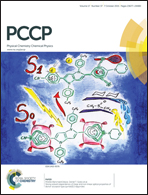The role of the local chemical environment of Ag on the resistive switching mechanism of conductive bridging random access memories†
Abstract
Conductive bridging random access memories (CBRAMs) are one of the most promising emerging technologies for the next generation of non-volatile memory. However, the lack of understanding of the switching mechanism at the nanoscale level prevents successful transfer to industry. In this paper, Ag/GeSx/W CBRAM devices are analyzed using depth selective X-ray Absorption Spectroscopy before and after switching. The study of the local environment around Ag atoms in such devices reveals that Ag is in two very distinct environments with short Ag–S bonds due to Ag dissolved in the GeSx matrix, and longer Ag–Ag bonds related to an Ag metallic phase. These experiments allow the conclusion that the switching process involves the formation of metallic Ag nano-filaments initiated at the Ag electrode. All these experimental features are well supported by ab initio molecular dynamics simulations showing that Ag favorably bonds to S atoms, and permit the proposal of a model at the microscopic level that can explain the instability of the conductive state in these Ag–GeSx CBRAM devices. Finally, the principle of the nondestructive method described here can be extended to other types of resistive memory concepts.


 Please wait while we load your content...
Please wait while we load your content...